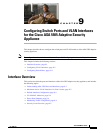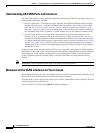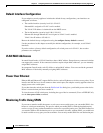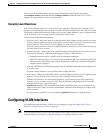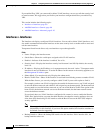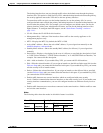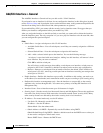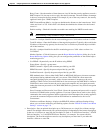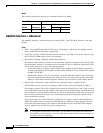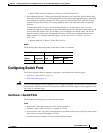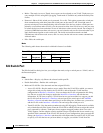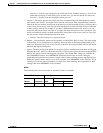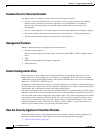
9-9
Cisco ASDM User Guide
OL-16647-01
Chapter 9 Configuring Switch Ports and VLAN Interfaces for the Cisco ASA 5505 Adaptive Security Appliance
Configuring VLAN Interfaces
Retry Count—Sets the number of times between 4 and 16 that the security appliance resends a
DHCP request if it does not receive a reply after the first attempt. The total number of attempts
is the retry count plus the first attempt. For example, if you set the retry count to 4, the security
appliance sends up to 5 DHCP requests.
DHCP Learned Route Metric—Assigns an administrative distance to the learned route. Valid
values are from 1 to 255. If this field is left blank, the administrtive distance for the learned
routes is 1.
Enable tracking—Check this checkbox to enable route tracking for DHCP-learned routes.
Note Route tracking is only available in single, routed mode.
Track ID—A unique identifier for the route tracking process. Valid values are from 1 to 500.
Track IP Address—Enter the IP address of the target being tracked. Typically, this would be the
IP address of the next hop gateway for the route, but it could be any network object available
off of that interface.
SLA ID—A unique identifier for the SLA monitoring process. Valid values are from 1 to
2147483647.
Monitor Options—Click this button to open the Route Monitoring Options dialog box. In the
Route Monitoring Options dialog box you can configure the parameters of the tracked object
monitoring process.
–
Use PPPoE—Dynamically sets the IP address using PPPoE.
Group Name—Specify a group name.
PPPoE Username—Specify the username provided by your ISP.
PPPoE Password—Specify the password provided by your ISP.
Confirm Password—Specify the password provided by your ISP.
PPP Authentication—Select either PAP, CHAP, or MSCHAP. PAP passes cleartext username
and password during authentication and is not secure. With CHAP, the client returns the
encrypted [challenge plus password], with a cleartext username in response to the server
challenge. CHAP is more secure than PAP, but it does not encrypt data. MSCHAP is similar to
CHAP but is more secure because the server stores and compares only encrypted passwords
rather than cleartext passwords as in CHAP. MSCHAP also generates a key for data encryption
by MPPE.
Store Username and Password in Local Flash—Stores the username and password in a special
location of NVRAM on the security appliance. If an Auto Update Server sends a clear config
command to the security appliance and the connection is then interrupted, the security appliance
can read the username and password from NVRAM and re-authenticate to the Access
Concentrator.
IP Address and Route Settings—displays the PPPoE IP Address and Route Settings dialog
where you can choose addressing and tracking options. See the “PPPoE IP Address and Route
Settings” section on page 7-9.
• Description—Sets an optional description up to 240 characters on a single line, without carriage
returns. For multiple context mode, the system description is independent of the context description.
In the case of a failover or state link, the description is fixed as “LAN Failover Interface,” “STATE
Failover Interface,” or “LAN/STATE Failover Interface,” for example. You cannot edit this
description. The fixed description overwrites any description you enter here if you make this
interface a failover or state link.



